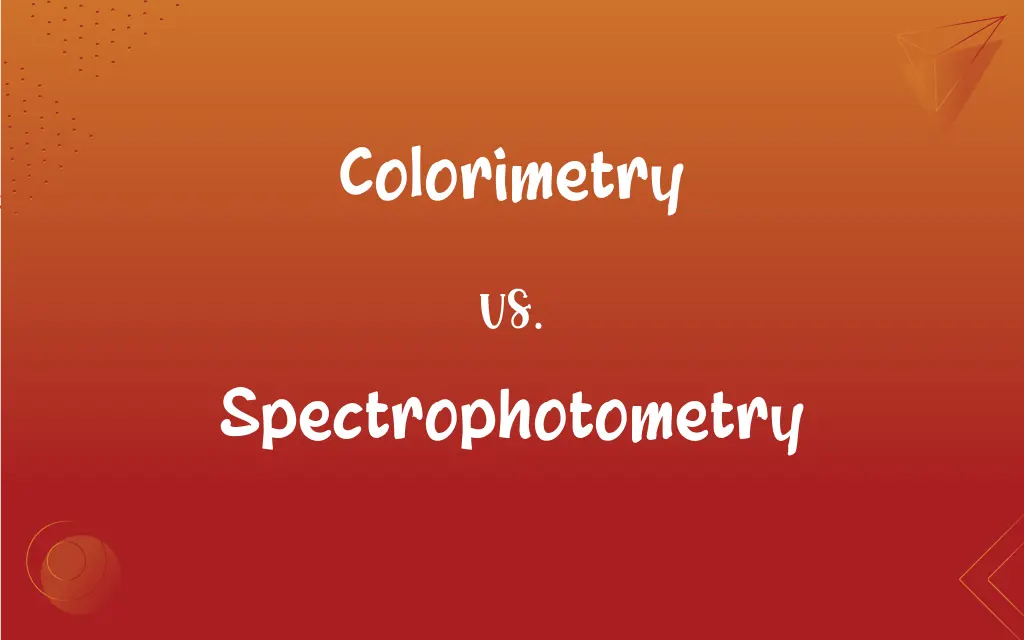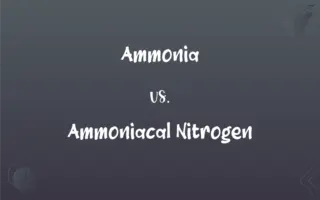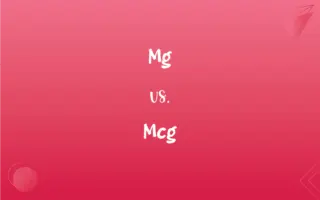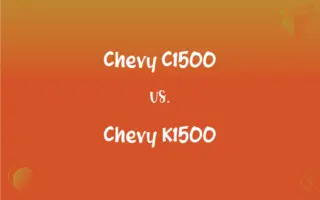Colorimetry vs. Spectrophotometry: What's the Difference?
Edited by Aimie Carlson || By Janet White || Published on February 11, 2024
Colorimetry measures the intensity of colors in a substance, while spectrophotometry measures the amount of light absorbed by a solution across a spectrum of wavelengths.

Key Differences
Colorimetry involves the quantitative determination of color intensity or concentration of color-producing substances. Spectrophotometry, on the other hand, quantitatively measures the absorption or transmission of light by a solution across a range of wavelengths.
In colorimetry, specific wavelengths are used to measure the absorbance related to the color of a sample, often with the use of filters. Spectrophotometry measures the intensity of light across a broad spectrum, providing detailed information about the substance.
Colorimetry is simpler and less detailed, typically used for straightforward analysis of colored solutions. Spectrophotometry offers more detailed analysis, including information on molecular structure and concentration of the analyte.
The equipment used in colorimetry is generally simpler and less expensive than that used in spectrophotometry. Spectrophotometers, with their ability to scan across wavelengths, are more complex and versatile in various scientific applications.
Colorimetry is often used in water testing, food quality control, and blood analysis. Spectrophotometry has broader applications, including chemical analysis, biochemistry, and pharmaceuticals.
ADVERTISEMENT
Comparison Chart
Measurement Focus
Color intensity of substances.
Light absorption across a spectrum.
Complexity
Less complex, often uses filters.
More complex, measures a range of wavelengths.
Information Provided
Basic concentration or color intensity.
Detailed molecular information.
Equipment Cost
Generally less expensive.
More expensive due to advanced technology.
Applications
Water testing, food quality, blood tests.
Biochemistry, pharmaceuticals, chemical analysis.
ADVERTISEMENT
Colorimetry and Spectrophotometry Definitions
Colorimetry
Analyzing the concentration of colored compounds.
Food dye concentration in drinks was measured using colorimetry.
Spectrophotometry
Measures light absorption at various wavelengths.
Spectrophotometry helped identify the unknown compound's spectral signature.
Colorimetry
Involves comparison of a sample's color to standard colors.
The colorimetry test matched the sample's color to known standards.
Spectrophotometry
Analyzes substances based on light spectrum interaction.
Protein concentrations were measured using spectrophotometry.
Colorimetry
Uses selective absorption of light by colored substances.
The purity of wastewater was assessed with colorimetry.
Spectrophotometry
Involves quantitative analysis of molecular components.
Pharmaceutical ingredients were quantified through spectrophotometry.
Colorimetry
Measurement of color intensity in solutions.
Colorimetry was used to determine the chlorine levels in the pool water.
Spectrophotometry
Provides insight into chemical structure and concentration.
The researcher used spectrophotometry to study reaction kinetics.
Colorimetry
Any of various instruments used to determine or specify colors, as by comparison with spectroscopic or visual standards.
Spectrophotometry
Utilizes full spectrum of light for detailed analysis.
The spectrophotometry results showed different absorbance peaks.
Colorimetry
An instrument that measures the concentration of a known constituent of a solution by comparison with colors of standard solutions of that constituent.
Spectrophotometry
An instrument used to determine the relative intensity of various wavelengths in a spectrum of light.
Colorimetry
The science of measuring colours and assigning them numeric values.
Spectrophotometry
The quantitative analysis of electromagnetic spectra by use of a spectrophotometer; especially in order to determine the structure or quantity of a substance
Colorimetry
(analytical chemistry) Analysis involving the quantitative measurement of colour.
Spectrophotometry
The art of comparing, photometrically, the brightness of two spectra, wave length by wave length; the use of the spectrophotometer.
Colorimetry
The quantitative determination of the depth of color of a substance.
Spectrophotometry
The art or process of measuring the degree of absorption of light at different wavelengths by a chemical substance, by means of a spectrometer or spectrophotometer. It is a technique for chemical analysis.
Colorimetry
A method of quantitative chemical analysis based upon the comparison of the depth of color of a solution with that of a standard liquid.
Colorimetry
Quantitative chemical analysis by color using a colorimeter
Colorimetry
A method to quantify color using visible light.
Blood samples were analyzed for hemoglobin levels through colorimetry.
FAQs
Are colorimetry instruments expensive?
They are generally less expensive than spectrophotometers.
Can colorimetry identify chemical structures?
No, it primarily measures color intensity.
What does colorimetry measure?
The intensity of colors in a substance.
What type of light does spectrophotometry use?
It uses a broad range of the light spectrum.
What is spectrophotometry used for?
Measuring light absorption across different wavelengths.
Can colorimetry measure non-colored substances?
No, it is limited to colored compounds.
Is spectrophotometry suitable for complex mixtures?
Yes, it can analyze complex mixtures in detail.
Is spectrophotometry more detailed than colorimetry?
Yes, it provides more comprehensive molecular information.
Does colorimetry require specialized training?
It requires basic training, less than spectrophotometry.
What is a common application of colorimetry?
Water quality testing and food color analysis.
Can spectrophotometry identify unknown substances?
Yes, through their absorption spectra.
Is colorimetry limited by the color range?
Yes, it only analyzes visible colors.
Can spectrophotometry measure concentration?
Yes, it can measure the concentration of substances.
What industries use spectrophotometry?
Biochemistry, pharmaceuticals, and chemical industries.
Is colorimetry a qualitative method?
It can be both qualitative and quantitative.
How accurate is colorimetry?
It is accurate for color intensity measurements.
Does spectrophotometry require a clear solution?
Clear solutions are preferred for accurate measurements.
What samples can be tested with colorimetry?
Any sample with color, like liquids and dissolved solids.
Is spectrophotometry useful in medical diagnostics?
Yes, particularly in biochemical analysis.
Can spectrophotometry detect impurities?
Yes, it can detect and quantify impurities.
About Author
Written by
Janet WhiteJanet White has been an esteemed writer and blogger for Difference Wiki. Holding a Master's degree in Science and Medical Journalism from the prestigious Boston University, she has consistently demonstrated her expertise and passion for her field. When she's not immersed in her work, Janet relishes her time exercising, delving into a good book, and cherishing moments with friends and family.
Edited by
Aimie CarlsonAimie Carlson, holding a master's degree in English literature, is a fervent English language enthusiast. She lends her writing talents to Difference Wiki, a prominent website that specializes in comparisons, offering readers insightful analyses that both captivate and inform.

































































